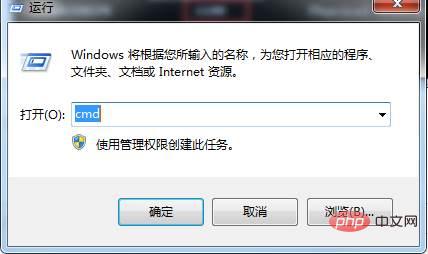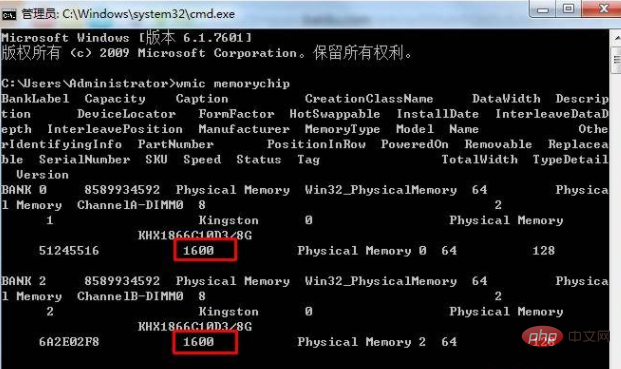What is the memory frequency?
The frequency of the memory module refers to the main frequency of the memory, which refers to the highest operating frequency that the memory can achieve. It can be used to indicate the speed of the memory. There are two ways to express the frequency of memory modules, namely working frequency and equivalent frequency. The working frequency is the actual working frequency of the memory particles. The equivalent frequency is different. The equivalent frequency of DDR memory is twice the working frequency. The equivalent frequency of DDR2 is Four times the operating frequency.

The operating environment of this tutorial: Windows 7 system, Dell G3 computer.
What is the frequency of the memory module?
The frequency of the memory module refers to the main frequency of the memory, which refers to the highest working frequency that the memory can achieve. Frequency is used to indicate the speed of memory. Memory clock speed is measured in MHz (megahertz). The higher the memory frequency, to a certain extent, the faster the memory can achieve. The memory frequency determines the highest frequency at which the memory can work normally.
There are two ways to express the frequency of memory modules, namely the working frequency and the equivalent frequency. The working frequency is the actual working frequency of the memory particles. The equivalent frequency is different. The equivalent frequency of DDR memory is twice the working frequency. , the DDR2 equivalent frequency is four times the operating frequency.

Description:
The clock speed of a computer system is measured in frequency. The crystal oscillator controls the clock speed. When a voltage is applied to the quartz wafer, it vibrates in the form of a sine wave. This vibration can be recorded through the deformation and size of the wafer. The vibration of the crystal is expressed in the form of a sinusoidal harmonic changing current, and this changing current is the clock signal. The memory itself does not have a crystal oscillator, so the clock signal when the memory is working is provided by the north bridge of the motherboard chipset or directly by the clock generator of the motherboard. That is to say, the memory cannot determine its own operating frequency. Its actual operating frequency It is determined by the motherboard.
How to check the memory frequency
Method 1: Via CMD command
1. Open Command prompt, open CMD while running

2. Enter the command in the command prompt: wmic memorychip

The red box above is the frequency of the memory module. The editor has two memory modules, DDR3 1600.
Method 2: Memory detection tool
1. Download the Chinese version of CPU-Z
2. After opening it, in the memory item, we You can see that the memory frequency is 799.9MHZ, but since it is dual-channel, we have to multiply by 2, so the memory frequency is about 1600.
Extended knowledge:
The memory asynchronous working mode contains a variety of meanings. In a broad sense, any memory When the working frequency is inconsistent with the CPU's FSB, it can be called the memory asynchronous working mode.
First of all, the earliest memory asynchronous working mode appeared in early motherboard chipsets, which can make the memory work in a mode that is 33MHz higher or lower than the CPU FSB (note that the difference is only 33MHz), so that it can Improve system memory performance or allow old memory to continue to use its residual heat.
Secondly, in normal working mode (CPU is not overclocked), many motherboard chipsets also support memory asynchronous working mode, such as Intel 910GL chipset, which only supports 533MHz FSB or 133MHz CPU FSB. But it can work normally with DDR 266 with an operating frequency of 133MHz, DDR 333 with an operating frequency of 166MHz, and DDR 400 with an operating frequency of 200MHz (note that at this time, the CPU FSB of 133MHz and the operating frequency of DDR 400 of 200MHz are already 66MHz different) , but the performance is different when paired with different memories.
Again, in the case of CPU overclocking, in order not to let the memory hinder the CPU's overclocking ability, the working frequency of the memory can be lowered to facilitate overclocking. For example, AMD's Opteron 144 with Socket 939 interface is very It is easy to overclock. The external frequency of many products can easily exceed 300MHz. If the memory is in synchronized working mode, the equivalent frequency of the memory will be as high as DDR 600. This is obviously impossible. In order to smoothly overclock the external frequency of 300MHz, Frequency, we can set the memory to DDR 333 or DDR 266 in the motherboard BIOS before overclocking. After overclocking the 300MHz FSB, the former is only DDR 500 (some top-quality memory can reach it), while the latter is only DDR. 400 (completely a normal standard frequency), it can be seen that correctly setting the memory asynchronous mode will help overclocking success.
For more related knowledge, please visit the FAQ column!
The above is the detailed content of What is the memory frequency?. For more information, please follow other related articles on the PHP Chinese website!

Hot AI Tools

Undresser.AI Undress
AI-powered app for creating realistic nude photos

AI Clothes Remover
Online AI tool for removing clothes from photos.

Undress AI Tool
Undress images for free

Clothoff.io
AI clothes remover

Video Face Swap
Swap faces in any video effortlessly with our completely free AI face swap tool!

Hot Article

Hot Tools

Notepad++7.3.1
Easy-to-use and free code editor

SublimeText3 Chinese version
Chinese version, very easy to use

Zend Studio 13.0.1
Powerful PHP integrated development environment

Dreamweaver CS6
Visual web development tools

SublimeText3 Mac version
God-level code editing software (SublimeText3)

Hot Topics
 Can the computer be turned on if the memory module is broken?
Feb 20, 2023 pm 02:10 PM
Can the computer be turned on if the memory module is broken?
Feb 20, 2023 pm 02:10 PM
If the memory module is broken, the computer cannot be turned on. If the memory module is broken, there will be two situations: 1. The computer cannot be turned on normally. This situation is a very common type of memory failure. Basically, it is manifested as the chassis issuing a sound when turning on the computer. Didi's warning sound, unable to enter the system or the display does not light up; 2. Frequent blue screens or crashes. A blue screen appears after booting. Most of them are memory errors that cannot be recognized.
 Supporting the new generation of CAMM2 memory modules, MSI and ASRock exhibited special Intel motherboards
Jun 07, 2024 am 11:23 AM
Supporting the new generation of CAMM2 memory modules, MSI and ASRock exhibited special Intel motherboards
Jun 07, 2024 am 11:23 AM
According to news from this site on June 4, based on reports from Taiwanese media BenchLife.info and updates from X platform user @wagipon, both MSI and ASRock exhibited special Intel motherboards that support CAMM2 memory modules at the 2024 Taipei International Computer Show. Among them, MSI brought the previously warmed-up Z790PROJECTZEROPLUS (CAMM2) motherboard, which is equipped with the FURYImpactDDR5CAMM2 prototype memory module from Kingston. ▲Picture source BenchLife.info MSI stated that the DDR5CAMM2 memory module can support up to 128GB capacity, and a single module can achieve dual channels, which can reduce compatibility issues (Note from this site: Even if only the batch number is different, the traditional
 How does cpu-z check the memory frequency?
Mar 13, 2023 pm 03:55 PM
How does cpu-z check the memory frequency?
Mar 13, 2023 pm 03:55 PM
How to check the frequency of the memory module with cpu-z: 1. Download the compressed package version of the cpuz software from the official website; 2. Unzip the downloaded compressed package, open the folder, and select the corresponding software to run according to the computer model; 3. In the running interface, Click the "Memory" tab in the menu bar to see the memory frequency of the memory module.
 Up to 6800CL34, ADATA XPG launches ASUS TUF GAMING co-branded Longyao D300G memory module
Jun 20, 2024 pm 08:23 PM
Up to 6800CL34, ADATA XPG launches ASUS TUF GAMING co-branded Longyao D300G memory module
Jun 20, 2024 pm 08:23 PM
According to news from this website on June 20, XPG, the gaming hardware brand of ADATA, recently launched the Longyao D300GTUFGAMING co-branded DDR5U-DIMM memory module, which is available in black and white. This series of co-branded memory modules is based on the original Longyao D300G, and the cooling vest is decorated with ASUS TUFGAMING "E-Sports Agent" themed text and graphics. According to ADATA, the Longyao D300GTUFGAMING co-branded memory module is specially designed for FPS game enthusiasts. It has excellent appearance and high performance, meeting the stringent requirements of FPS games for hardware stability. Longyao D300GTUFGAMING co-branded memory is 40mm high, available in 6000CL30, 6400CL32 and 68
 How to adjust the memory frequency
Feb 22, 2024 pm 12:00 PM
How to adjust the memory frequency
Feb 22, 2024 pm 12:00 PM
How to adjust the memory frequency In the computer hardware configuration, memory plays a very important role. The frequency of the memory module determines its operating speed and stability. For some computer enthusiasts and gamers, adjusting the frequency of the memory module can improve computer performance. So, how to adjust the memory frequency? First of all, we need to understand that the frequency of the memory module is determined by the support capabilities of the motherboard and the memory module itself. The motherboard has a maximum supported frequency range, and the memory module also has its own specifications and maximum supported frequency. Adjusting memory frequency
 Does Thinkbook 15P support memory expansion?
Jan 18, 2024 am 09:06 AM
Does Thinkbook 15P support memory expansion?
Jan 18, 2024 am 09:06 AM
After buying the thinkbook15P notebook, many users find that it has only one memory, so they are worried that it will not be used enough. They want to add a memory stick but are not sure whether it can be installed. In fact, there is no problem and it can be installed according to needs. Can memory modules be added to thinkbook15P? Answer: Memory modules can be added to thinkbook15P. thinkbook15P has a single 16g memory, so you can add 16g or 32g without any problem. Introduction to thinkbook15P performance expansion: 1. Thinkbook15P runs very fast, and the response is not laggy. It can be supported by wifii6, and the effect is good. 2. It will not have any impact when used, and the heat dissipation is also good.
 How memory frequency affects performance
Feb 23, 2024 pm 10:54 PM
How memory frequency affects performance
Feb 23, 2024 pm 10:54 PM
Memory frequency is one of the important parameters of computer memory. It refers to the frequency of data transmission speed of the memory module. When choosing memory, we often pay attention to the memory frequency, because the memory frequency directly affects the performance of the computer. This article explores the impact of memory frequency on computer performance. First, an increase in memory frequency can increase the computer's data transfer speed. Memory is where the computer stores data, and when the computer is running tasks, it needs to constantly read and write data. The higher the memory frequency, the faster the data transfer speed.
 Can memory sticks of different brands be mixed?
Dec 18, 2023 pm 04:39 PM
Can memory sticks of different brands be mixed?
Dec 18, 2023 pm 04:39 PM
Memory modules of different brands can generally be mixed. As long as their parameters such as frequency, capacity and interface are the same, they can be mixed. Different brands of memory modules may have differences in production processes and quality. Mixing them may cause unstable computer performance or other problems. Therefore, when choosing a memory module, it is recommended to choose a memory module of the same brand and model to ensure the stability and performance of the computer.






